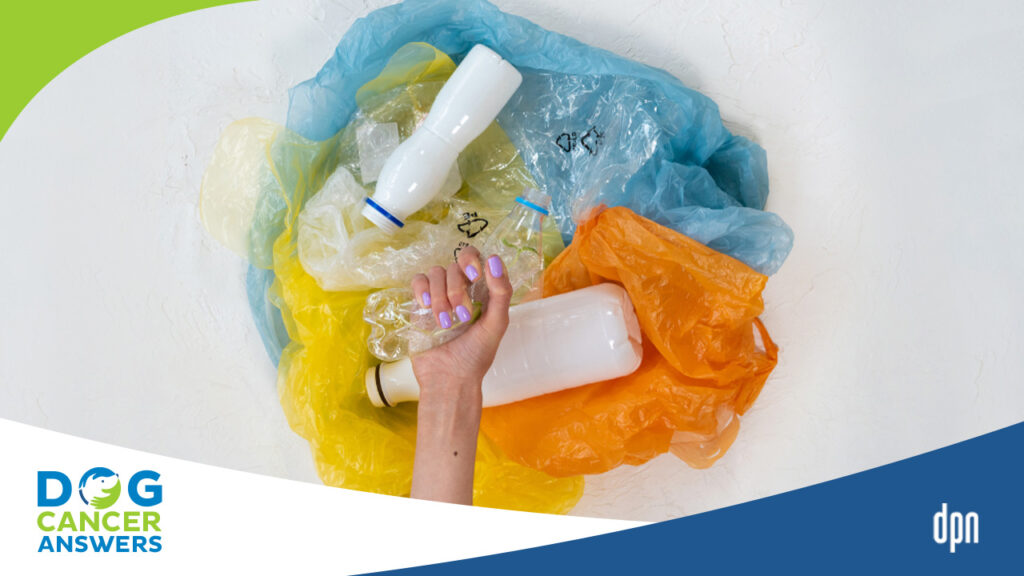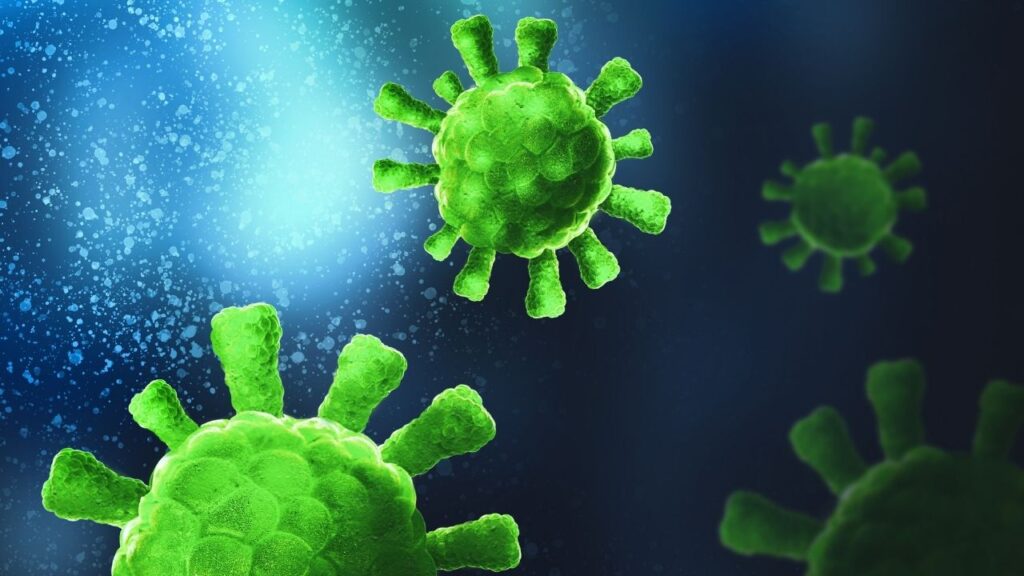Plastic use is ubiquitous throughout our daily lives, but plastics can be packed with some hard-hitting chemicals known to be dangerous for human (and canine!) health. Even concerted efforts to minimize plastic use and make conscious purchases when it comes to our dogs can come up short in reducing their exposure to toxic chemicals found in this once considered “wonder material.” Does plastic cause cancer in dogs? What are the real dangers? Hard numbers are difficult to come by, but overall, it’s clear that we should reduce exposure to plastics in general.
Key Takeaways
- We do not know exactly what level of plastic exposure is toxic to dogs, or humans, for that matter.
- The more we learn, the more concerned we are about known carcinogens like BPA, phthalates, and even lead leaching out of plastic.
- Plastic can degrade over time and with heat and cold, so plastic water bottles could in theory ultimately contribute to cancer risk in dogs, although the specific risks are not easy to calculate.
- Dog toys are not subject to the same regulations as children’s toys, so they may contain plastics or amounts of plastics that could degrade and leach out chemicals that are known to be linked to cancer.
Plastic Causes Dog Cancer – True, or False?
There are many scary articles on the internet about plastics and their impact on our health and the health of our dogs. So, can plastic cause cancer in dogs? As usual, the answer is not a simple “yes,” or “no.”
Most cancers do not have “just one cause” and cannot be traced back to one single event or exposure. Many things must go wrong for cancer to take root. That said, plastics are made with known carcinogens (see below) and reducing your dog’s exposure to them is important whether your dog has cancer or not.
The more we learn about plastic and the way it breaks down over time, the more concern we have about its long-term impacts on the health of humans, animals, and the environment.
Plastic is a product that is now so common in our lives it is impossible to avoid, and you should not beat yourself up about using it or having it in your environment. As we will see, it is everywhere.
In this article we are going to cover the problematic chemicals in plastic that could increase cancer risk in dogs, and give you very concrete steps to take now to reduce your dog’s plastic exposure.
But plastic came from humble beginnings, with an intent to help, not harm, the environment and humans. The backstory of plastic helps to show why there is so much of it in our modern lives and reveals why it can be problematic.
Plastic: a “Wonder Material” That Makes Our Life Much Easier
The ivory market in the mid-1800s was taking a heavy toll on elephants. The demand for their tusks to make chess boards, jewelry, billiard balls, trinkets, and piano keys was decimating their populations in Africa. The price of raw ivory skyrocketed.
To help save money and take the pressure off the iconic species, a firm in New York offered to pay $10,000 in 1863 to anyone who could make a product similar enough to ivory that it could replace it functionally and aesthetically.1
Nitrocellulose, or Celluloid
Inventor John Wesley Hyatt answered that call by experimenting with hardened nitrocellulose. Though other similar products had been previously made, Hyatt’s was the first that could be commercially produced en masse. He patented his creation in 1869 under the name “Celluloid.”1
The evolution of plastic as we know it today continued. Celluloid required camphor; a chemical made by distilling down the bark of the camphor tree. This put some dependence on mother nature for manufacturing the product. What would happen if camphor trees were over-harvested?
The First Completely Synthetic Plastic Made Everything Possible
In 1907 Leo Baekeland constructed the first fully synthetic mass producible plastic.1 This opened the flood gates for humans to synthetically make whatever they desired.
World War II expedited the production and experimentation with plastic.1 More and more people started to see plastic enter their everyday lives and make it easier.
The enthusiasm for all things plastic hit a fever pitch post-World War II until the 1960s, when the first piece of plastic trash was found in the ocean.1 Public support began to shift, and people started questioning the environmental and health concerns that had evaded the industry’s radar for years.1
Today, the public is still grappling with those questions. What exactly is in plastic, what happens to it over time, and does it harm health?
Toxic Chemicals in Plastic Mimic Natural Hormones
One of the main concerns surrounding plastic is that it contains chemicals that, if ingested, can mimic the body’s own hormones. Chemicals that can disrupt or mimic natural hormones are called endocrine disruptors.
Hormones have powerful effects in the body, and the right balance is critical to health in general in both dogs and people.
The main chemicals of concern (so far) in plastics are:
Bisphenol A (BPA)
Bisphenol A (BPA) is an industrial chemical commonly used in clear hard plastics to stop them from breaking down. About 67% of BPA production is used to make polycarbonate plastic and 30% is used to make epoxy resin.2
At this point, BPA is well-known to interfere with the normal functioning of hormones in the body. Even at low doses, consistent and long-term exposure can disrupt development and alter necessary bodily functions.3
Phthalates
Phthalates constitute a whole group of chemicals typically used to make plastics softer so they can be made into thinner and more flexible shapes. They can be found in many common products like flooring, but also in personal care products like shampoos. They may also be referred to as “plasticizers.”4
Similar to BPA, phthalates are also well known and well recognized endocrine disrupters.2 In fact, six phthalates – Benzyl butyl phthalate (BBP), Bis (2-ethylhexyl) phthalate (DEHP), Dibutyl phthalate (DBP), Di-‘isodecyl’ phthalate (DIDP), Di-‘isononyl’ phthalate (DINP), and Di-n-ocytl phthalate (DNOP) – are considered “restricted substances” under the United States Consumer Products Safety Improvement Act, and are considered “substances of very high concern” in the European Union and Japan.4
Polyvinyl Chloride
Often simply known as “vinyl” or “PVC,” polyvinyl chloride is extensively used in the construction, healthcare, and packaging industries.5 The most familiar example of PVC may be the pipes used for plumbing systems.
PVC is not a known carcinogen6, but BPA and phthalates must be added to it to make it moldable, workable, and flexible.7 As mentioned above, these are well known hazardous chemicals.
Note: You may be familiar from the news with a similarly named gas, vinyl chloride, which is a known carcinogen.6 This gas is used to manufacture PVC, but the amount present in PVC itself is very small. It can leach out of PVC over time and under the right (extreme) circumstances, but the major risk from vinyl chloride gas is workers in manufacturing facilities being exposed to it, or from environmental accidents.8
Lead
Lead was once commonly added to products containing polyvinyl chloride to make it easier to work with and to improve its long-term stability.9
Despite the very well-known dangers of lead exposure, its use in plastics has still not been banned.9
Alkylphenols
Like phthalates, alkylphenols are used as a plasticizer. Their derivatives, alkylphenol phosphites, are used to protect plastics from degradation due to ultraviolet light.
Alkylphenols can undergo a wide range of chemical reactions that make them useful for many commercial applications. Unfortunately, they have also been implicated as endocrine disruptors.10
Some countries don’t allow anything to be made with certain types of alkylphenols. For example, the EU has a ban on nonylphenols.11
Dr. Charlotte Hacker explains why plastic found in every day items poses a health risk.
How Do Plastics Affect Dogs?
We often assume that because plastic is hard and seems to last for a long time, that it is safe. The chemicals of concern listed above are “locked in” to the plastic, right? How can plastic cause cancer in dogs if they don’t eat it?
It’s not that simple, unfortunately. Most of these chemicals aren’t well bound to each other in plastic and their bonds easily break, especially when heated12,13,14 or frozen.15
When their bonds break, the chemicals can “leach” out of plastic over time and through use. They are subsequently released into their surrounding environment and can enter your dog’s body.
For example, epoxy resin is commonly used to coat the inside of dog food cans to prevent a metallic taste.2 The BPA in the epoxy resin lining of the can will eventually leach into the food contained in the can, and into your dog’s body when they eat it.
Similarly, a plastic chew toy containing phthalates to make it flexible and soft will release those phthalates as your dog chews on it and disrupts the bonds holding the product together.
How much of these substances does it take to cause cancer to develop? It is difficult to isolate hard numbers and assess the real risk, particularly when plastics are used in so many places and ways in daily life.
What We Know About How Plastics May Increase Cancer Risk in Dogs
There are multiple lines of evidence showing that BPA and phthalates are endocrine disrupters that interfere with hormones that are vital for development and biological function.2 It’s also important to know that negative impacts to the endocrine system have been noted even when only low levels of exposure were reported.3
However, definitive conclusions regarding cancer risk are difficult to gain via short term studies alone. For more meaningful answers, we would need to have cumulative lifetime exposure data with long term follow up.16
In short, scientists are still figuring out the role of plastic use and exposure in cancer.
Regardless, the global presence and increase of BPA in the environment have run congruently with increases in endocrine-related cancers, suggesting that some kind of link between the two exists.16 Let’s look more closely at BPA now.
BPA and Cancer Risk
It’s difficult to determine the amount of BPA that a body (any body) can tolerate before it starts to cause dangerous health problems.3 We don’t have hard numbers to offer, because, as noted above, the kind of studies that are required to generate them just don’t exist (and would be difficult to construct).
But the more we learn, the more common sense has helped us to see that reducing exposure is a good idea. BPA is well absorbed into the body when ingested orally, and concern over its environmental and physical impacts have warranted regulatory action.2
For example, BPA is banned in the production of baby bottles in the United States, European Union, and China.4 Similarly, certain phthalates have been banned in children’s toys in the United States and European Union.17
Can Plastic Dog Toys Cause Cancer?
Unfortunately, the standards for children’s toys do not apply to pet products, and there is no set maximum chemical exposure level outlined or enforced.18 Pet toys and other items that can be chewed on or ingested are only subject to extremely broad regulations under the Consumer Product Safety Commission, which only prevents the addition of hazardous substances.19
BPA in Dog Food: What’s Safe?
Even the levels of BPA in dog food are not well tracked. One study found an average concentration of 42 ng/g of BPA, with numbers ranging from 11 ng/g to 206 ng/g, among 11 different brands of canned dog food.20
Are those dangerous amounts? It’s difficult to definitively state whether they are or not. But nonetheless, they are concerning, because the chemicals in plastic can, at minimum, alter your dog’s gut microbiome, which has been linked to cancer.21
Even wide-ranging federal authorities don’t seem to be so sure what “safe” levels for humans are, let alone our canine counterparts.
- The European Food Safety Authority (EFSA) recently reevaluated tolerable intake levels of BPA in humans. After reviewing raw data from studies published between 2013 and 2018, the EFSA reduced levels from 4,000 ng/kg of body weight a day to a mere 0.04 ng/kg of body weight per day. That is a 100,000 times reduction!22
- In response to the findings outlined by the EFSA, the United States Food and Drug Administration (FDA) agreed to review its currently accepted level of 500 ng/kg of body weight a day.22
Regardless of what the “safe” level of BPA is eventually determined to be, the drastic swings in its recommended levels over the years shows how much we may still have to learn about BPA’s health impacts.
Canine Studies Looking at Whether Plastics Cause Dog Cancer
Keep in mind that dogs and humans are quite similar when it comes to cancer, which means that human medicine studies are often used to help veterinarians understand and treat dog cancer.
Relative to humans, there are very few studies on the effects of chemicals in plastics on dogs2, but we do have some studies to review.
One study investigated the impacts of 2,000, 6,000, and 18,000 ng of BPA per kg of body weight per day on the prostates of 24 adult Beagles. Researchers found that these doses could lead to the development of malignant tumor growth via the activation of specific genes associated with cancer development.3
Another study tested the exposure of BPA and phthalates on cells taken from the testicular tissue of dogs. The cells were plated in a laboratory and exposed to concentrations ranging from 0.001 to 2.5 nM.4
- DEHP (Bis (2-ethylhexyl) phthalate was found to be the most toxic while DMP (dimethyl phthalate) was the least toxic.
- Overall, testicular cells were more sensitive to phthalates with higher molecular weights than those with lower weights.
- Cellular changes in membrane integrity were obvious, and apoptotic bodies, indicative of cell death, were noted regardless of the phthalate type that cells were exposed to.4
Risk Factors for Dog Cancer and Plastics
Because BPA is an endocrine disrupter, it is more likely to be linked to endocrine related cancers such as breast, prostate, testicular, and ovarian cancer.2,16 This also means that intact males and females may be more at-risk due to higher risk for abnormalities to occur in the testes and ovaries.4
Certain behaviors may also increase the risk that a dog might suffer negative health effects from chemicals in plastic. For example, chewing is one of the most common ways that chemicals leach from dog toys and training devices.19 These chemicals enter your dog’s saliva and subsequently their body.19 This means that dogs who are “chewers” may be more at risk if they have access to products with these chemicals.
Keep in mind that BPA can cross the placental barrier and has been found in amniotic fluid and fetal plasma.16 This means that even the offspring of a “chewer” may be more at risk due to exposure in the womb, regardless of their own chewing behavior.
How to Reduce Plastic Exposure for Your Dog with Cancer
Plastic is unavoidable in modern life. It’s in your dog’s toys, crates, food storage containers, bowls, frisbees, pill bottles, gates, shampoo bottles, and more.
Even if a product itself is not plastic, it likely comes wrapped in plastic, or was contained in plastic at some point. Plastic parts and tools are used in manufacturing facilities, too.
Unless you live in a bubble (that is not made of plastic), it is not possible to completely avoid plastic exposure.
While plastics pose a cancer risk for healthy dogs, reducing exposure to any carcinogen once cancer has started may help your dog fight cancer, even just a little bit, by reducing the burden on their body overall.
Does removing all plastics from your dog’s environment cure cancer? No. Is it absolutely necessary? No, it’s not. But it might give you some peace of mind to take action so when you look back, you will be able to say, “I did what I could, even got rid of plastics.”
Keep Plastic Rules Simple
The risk of plastic leaching toxic chemicals goes up with use, time, heat, and cold, so here are some good rules of thumb:
- Reduce your use of plastic whenever possible.
- Replace plastics as they age. That “peeling” or roughened plastic item is definitely leaching something into your environment.
- Do not heat or freeze plastics that are not made to withstand extreme temperatures.
Keep Plastic Out of Your Dog’s Mouth, Toys, and Food
The main risk of exposure to harmful chemicals in plastic is through oral exposure, so you’ll want to focus on removing plastics with these chemicals from your dog’s daily life where possible.19
- Keep your dog’s treats and food in glass containers. Once you buy them (likely packaged in plastic), transfer the goodies to your own glass containers. This will minimize the issue of leaching once you’ve purchased the food and items you regularly feed them.
- If your dog eats canned food, use a brand that does not use BPA in the lining of their cans. (You can use the Environmental Working Group’s database.) More and more brands are ditching BPA linings in general, a trend we hope will continue.22
- Use metal or ceramic bowls for your dog’s food and water. These are also typically easier to clean. Wash them every day to keep them clean and safe from chemicals, but also yeasts, molds, and bacteria that may build up on their surfaces over time.
- Ditch any plastic toys you have and use rubber, hemp, or wool toys. Rubber toys without BPA may have latex, so be mindful if your dog has an allergy to latex. Hemp and wool toys are excellent – durable, safe, and they even float.
Good Habits to Reduce the Risk of Cancer from Plastic
There are other habits you can pick up and practice to incorporate long term and help reduce your dog’s (and your) exposure to the harmful chemicals found in plastic.
- Use plastic alternatives, such as glass, whenever possible. This not only ensures that your dog’s exposure is limited, but also reduces the demand for plastic overall.
- If you do use plastic, get in the habit of ditching it as it ages, because leaching risks are greater as plastic gets older.2 Recycling your older plastic is a good practice if possible, and replacing it with plastic made from recyclables is ideal.
- Avoid microwaving and freezing plastic containers, particularly those that are not specifically marked safe for microwaves and freezers. The freeze-thaw process can cause more BPAs to be released, and this only gets worse as the plastic container ages.
- Use a metal water container when traveling with your dog. There are several options on the market. Stainless steel containers ensure your dog has clean water free of BPA or phthalates.
- Purchase dog toys that are manufactured to the same standards as children’s toys. While the dog product market is largely unregulated, some companies adhere to the stricter standards regarding BPA and phthalates outlined for kids and say so on their packaging. Look for labels that say the toy is safe for children under the age of three. Purchasing from these companies will drastically reduce the chemicals in your dog’s toys and can help give you peace of mind.
- Get into the habit of reading labels. This can be applied to anything given to your dog, but food and toys both go in your dog’s mouth, so they are particularly important. Don’t assume that a product is safe; make sure that the label says “BPA free” and “phthalate free.”
Keep in mind that you don’t have to change everything out. For example, if your dog’s crate has plastic components but they don’t chew on it, then it’s likely fine to leave it as is.
Reducing your dog’s exposure to plastic is important, but be kind to yourself and remember that removing all plastic is impossible. Doing your best is enough.
Don’t Panic About Whether Plastics Cause Cancer in Dogs, Just Take Action
It can be overwhelming and upsetting to find out that something so fundamental to our daily lives as plastic can carry so many risks. But remember to be patient with yourself. It is, unfortunately, impossible to make your dog’s life completely plastic free.
Consumers are often at the mercy of manufacturers, and governmental regulators are not always on the ball. However, our individual actions do make a difference. Slight changes by consumers, “voting with our wallets,” sends a strong message about what we will and will not buy. Companies notice these “votes” and they can make a significant difference.
Start with simple swaps, ask retailers for alternatives, let companies know what choices you are making … and talk to your veterinarian about any concerns you may have about your dog’s lifetime exposure to chemicals such as BPA. We may not have the hard numbers (yet) to understand what those exposures mean in terms of your dog’s health, but having the conversation is a start to addressing the problem.
- History and future of plastics. Science History Institute. No publication date available. Accessed December 8, 2022. https://www.sciencehistory.org/the-history-and-future-of-plastics.
- Talpade J, Shrman K, Sharma RK, Gutham V, Singh RP, Meena NS. Bisphenol a: an endocrine disrupter. J of Entomol Zool Stud 2018;6(3):394-397.
- Wang K, Huang D, Zhou P, Su X, Yang R, Shao C, Wu J. Bisphenol A exposure triggers the malignant transformation of prostatic hyperplasia in beagle dogs via cfa-miR-204/KRAS axis. Exotoxicol Environ Saf 2022;235:113430. (https://www.sciencedirect.com/science/article/pii/S0147651322002706)
- Tekin K, Arslan P, Cil B, Filzai A, Akçay E, Yurdakok-Dikum B. Companion animals get close to toxic aspects of anthropogenic world: cytotoxicity of phthalates and bisphenol A on dog testicular primary cells. Cytotechnology 2020;75:629-238.
- Polyvinyl Chloride. ChemicalSafetyFacts.org – information on chemicals in everyday products. October 14, 2022. Accessed December 12, 2022. https://www.chemicalsafetyfacts.org/chemicals/polyvinyl-chloride/.
- Vinyl chloride – cancer-causing substances. National Cancer Institute. https://www.cancer.gov/about-cancer/causes-prevention/risk/substances/vinyl-chloride. Published November 3, 2022. Accessed March 1, 2023.
- Chung E. Wondering what all the fuss with polyvinyl chloride is about? Because Health & Center for Environmental Health. November 16, 2020. Accessed December 12, 2022. https://www.becausehealth.org/wondering-what-all-the-fuss-with-polyvinyl-chloride-is-all-about-2646144559.html.
- Public health statement: vinyl chloride . Department of Health and Human Services. https://www.atsdr.cdc.gov/ToxProfiles/tp20-c1-b.pdf. Published July 2006. Accessed March 1, 2023.
- Lead in Consumer Products. CDC Childhood Lead Poisoning Prevention. February 1, 2022. Accessed December 12, 2022. https://www.cdc.gov/nceh/lead/prevention/sources/consumer-products.
- Colin A, Bach C, Rosin C, Munoz JF, Dauchy X. Is drinking water a major route of human exposure to alkylphenol and bisphenol contaminants in France? Arch Environ Contam Toxicol 2014;66:86-99.
- The Controls on Nonylphenol and Nonylphenol Ethoxylate Regulations 2004, SI 2004 No.1816. legislation.gov.uk. https://www.legislation.gov.uk/uksi/2004/1816/pdfs/uksiem_20041816_en.pdf. Published 2004. Accessed December 15, 2022.
- Sáiz J, Gómara B. Evaluation of endocrine disrupting compounds migration in household food containers under domestic use conditions. Journal of agricultural and food chemistry. https://pubmed.ncbi.nlm.nih.gov/28735545/. Published August 9, 2017. Accessed March 1, 2023.
- Lim DS, Kwack SJ, Kim KB, Kim HS, Lee BM. Potential risk of bisphenol A migration from polycarbonate containers after heating, boiling, and microwaving. Journal of toxicology and environmental health. Part A. https://pubmed.ncbi.nlm.nih.gov/20077198/. Published 2009. Accessed March 1, 2023.
- Moreira MA, André LC, Cardeal ZL. Analysis of phthalate migration to food simulants in plastic containers during microwave operations. International journal of environmental research and public health. https://www.ncbi.nlm.nih.gov/pmc/articles/PMC3924457/. Published December 30, 2013. Accessed March 1, 2023.
- Dunn P. Why do plastics get brittle when they get cold? Ask an Engineer. https://engineering.mit.edu/engage/ask-an-engineer/why-do-plastics-get-brittle-when-they-get-cold/. Published June 2, 2009. Accessed March 1, 2023.
- Seachrist DD, Bonk KW, Ho SM, Prins GS, Soto AM, Keri RA. A review of the carcinogenic potential of bisphenol A. Reprod Toxiocol 2016:59:167-182.
- Phthalates Business Guidance & Small Entity Compliance Guide. U.S. Consumer Product Safety Commission. https://www.cpsc.gov/Business–Manufacturing/Business-Education/Business-Guidance/Phthalates-Information#:~:text=In%20addition%2C%20the%20phthalates%20rule,and%20dicyclohexyl%20phthalate%20(DCHP). Published November 26, 2019. Accessed December 14, 2022.
- Law library article: Before Entering the Pet Products Industry. American Pet Products Association. https://www.americanpetproducts.org/law/lawlibrary_article.asp?topic=62#:~:text=Toys%2Dthere%20is%20no%20specific,the%20Consumer%20Products%20Safety%20Commission. Accessed March 1, 2023.
- Wooten KJ, Smith PN. Canine toys and training devices as sources of exposure to phthalates and bisphenol A: Quantitation of chemicals in leachate and in vitro screening for endocrine activity. Chemosphere 2013;93(1):2245-2253.
- Kang JH, Kondo F. Determination of bisphenol A in canned pet foods. Res in Vet Sci 2002;73(2):177-182.
- Bell S. BPA linked to health concerns in dogs. The Wildest. March 7, 2010. Accessed December 8, 2022. https://www.thewildest.com/dog-health/bpa-health-concerns-dogs.
- Geller S. FDA agrees to renewed call for reassessing health risks of BPA in food packaging. Empowering Healthy Choices. June 6, 2022. Accessed December 12, 2022. https://www.ewg.org/news-insights/news/2022/06/fda-agrees-renewed-call-reassessing-health-risks-bpa-food-packaging.
Topics
Did You Find This Helpful? Share It with Your Pack!
Use the buttons to share what you learned on social media, download a PDF, print this out, or email it to your veterinarian.








